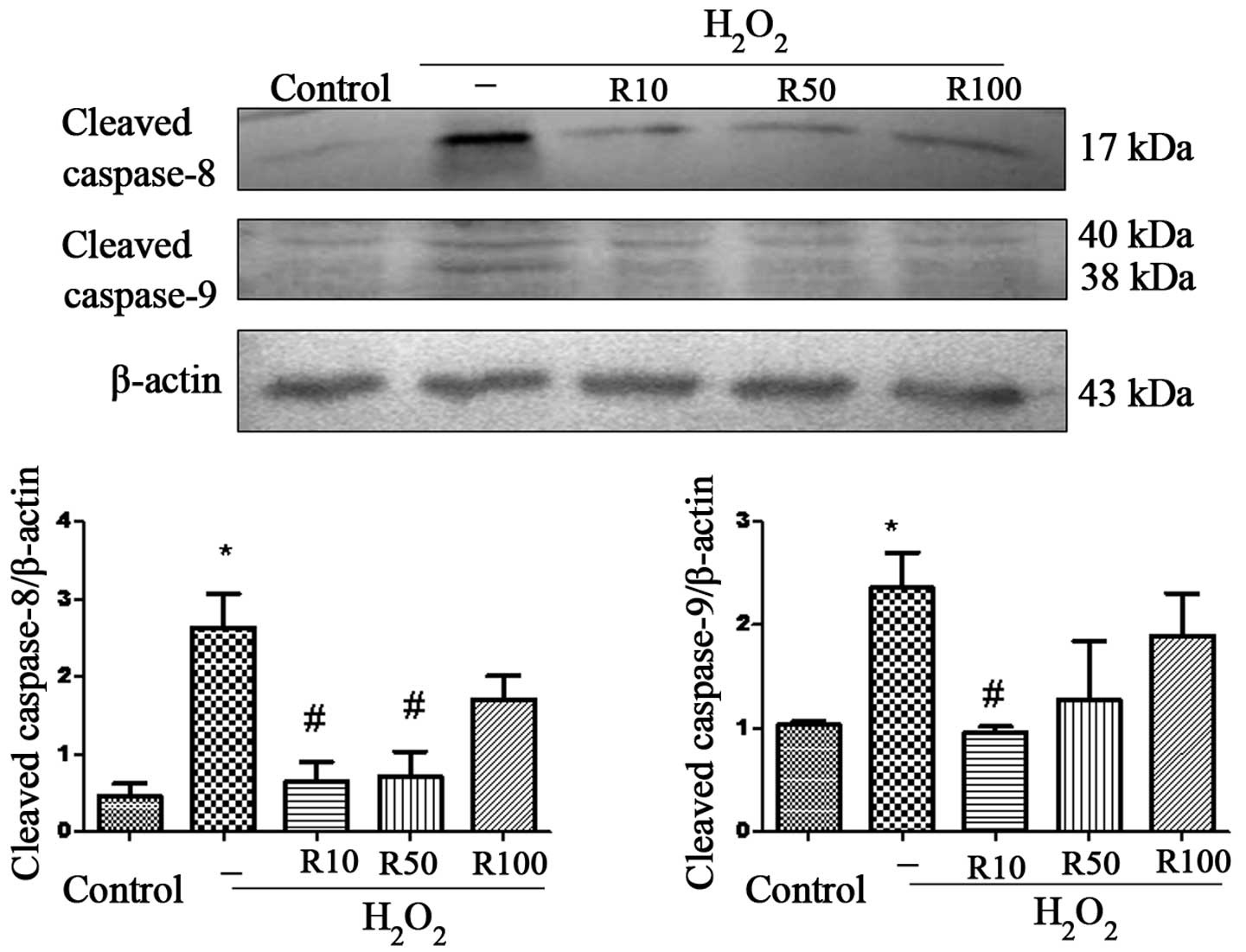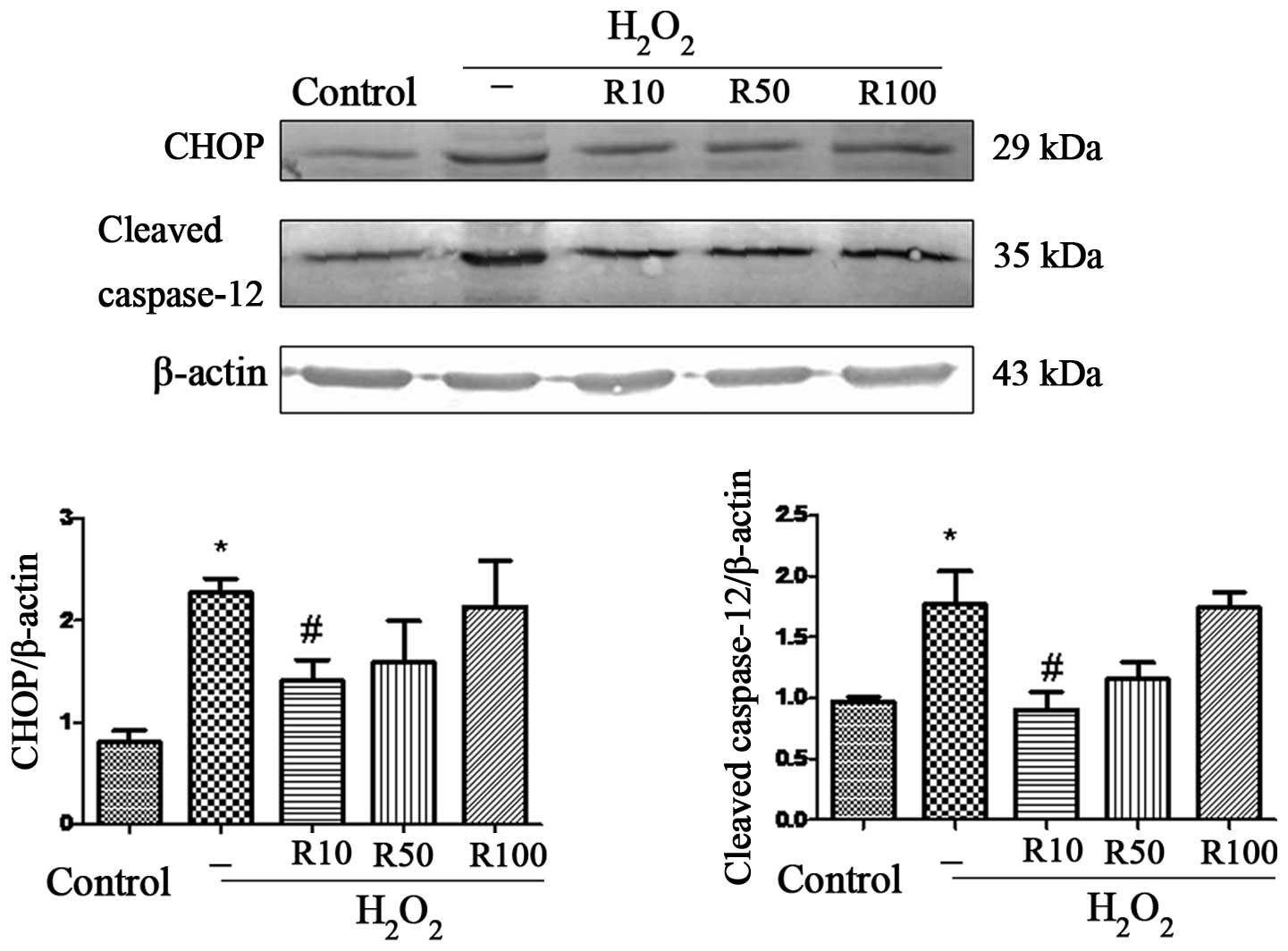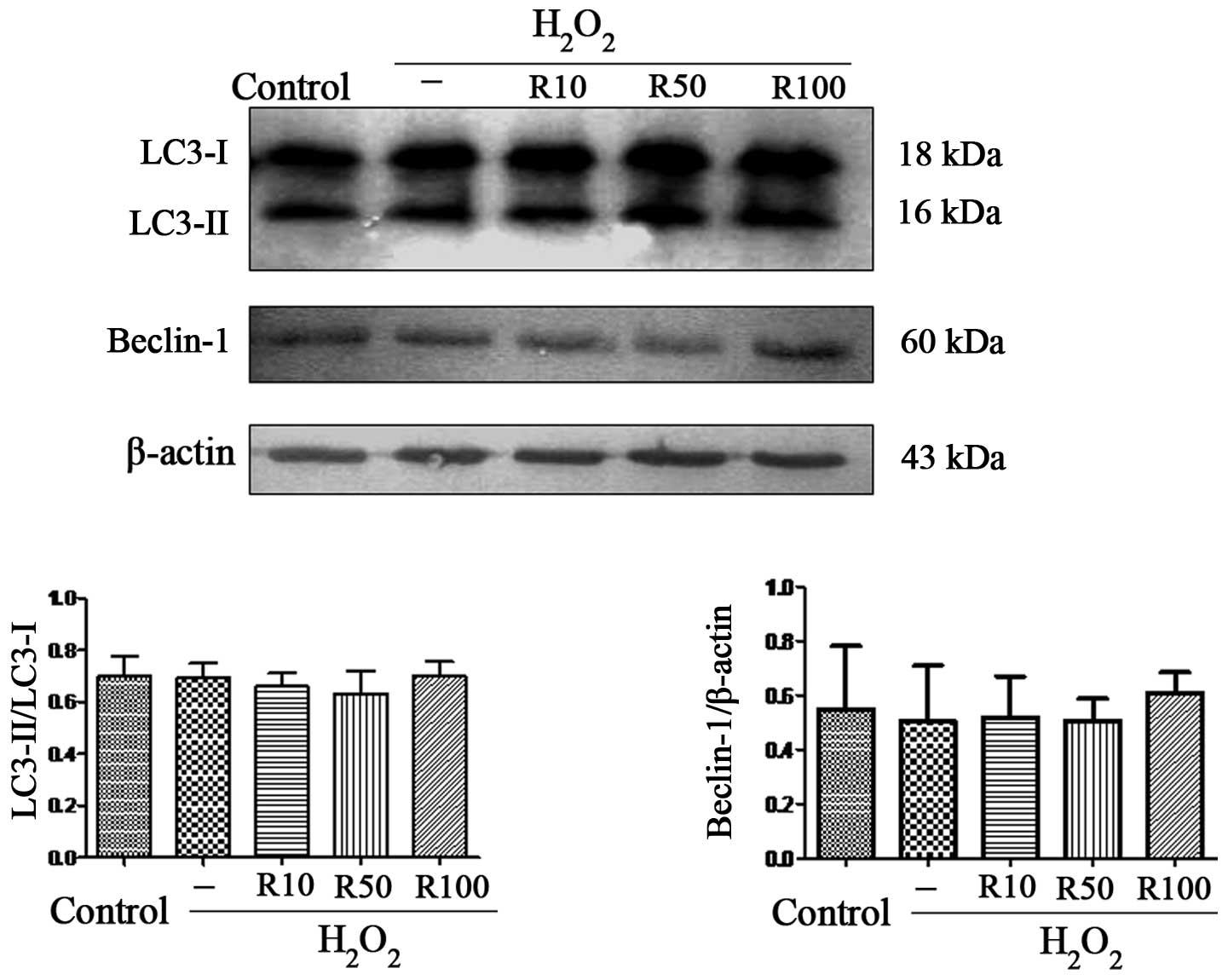|
1
|
Horvathova E, Eckl PM, Bresgen N and
Slamenova D: Evaluation of genotoxic and cytotoxic effects of H2O2
and DMNQ on freshly isolated rat hepatocytes; protective effects of
carboxymethyl chitin-glucan. Neuro Endocrinol Lett. 29:644–648.
2008.PubMed/NCBI
|
|
2
|
Miñana JB, Gómez-Cambronero L, Lloret A,
et al: Mitochondrial oxidative stress and CD95 ligand: a dual
mechanism for hepatocyte apoptosis in chronic alcoholism.
Hepatology. 35:1205–1214. 2002. View Article : Google Scholar : PubMed/NCBI
|
|
3
|
Jaeschke H, McGill MR and Ramachandran A:
Oxidant stress, mitochondria, and cell death mechanisms in
drug-induced liver injury: lessons learned from acetaminophen
hepatotoxicity. Drug Metab Rev. 44:88–106. 2012. View Article : Google Scholar : PubMed/NCBI
|
|
4
|
Kundu D, Roy A, Mandal T, Bandyopadhyay U,
Ghosh E and Ray D: Oxidative stress in alcoholic and viral
hepatitis. N Am J Med Sci. 4:412–415. 2012. View Article : Google Scholar : PubMed/NCBI
|
|
5
|
Koike K: Oxidative stress and apoptosis in
hepatitis C: the core issue. J Gastroenterol. 41:292–294. 2006.
View Article : Google Scholar : PubMed/NCBI
|
|
6
|
Rodrigues CM, Fan G, Wong PY, Kren BT and
Steer CJ: Ursodeoxycholic acid may inhibit deoxycholic acid-induced
apoptosis by modulating mitochondrial transmembrane potential and
reactive oxygen species production. Mol Med. 4:165–178.
1998.PubMed/NCBI
|
|
7
|
Canbay A, Gieseler RK, Gores GJ and Gerken
G: The relationship between apoptosis and non-alcoholic fatty liver
disease: an evolutionary cornerstone turned pathogenic. Z
Gastroenterol. 43:211–217. 2005. View Article : Google Scholar : PubMed/NCBI
|
|
8
|
Canbay A, Friedman S and Gores GJ:
Apoptosis: the nexus of liver injury and fibrosis. Hepatology.
39:273–278. 2004. View Article : Google Scholar : PubMed/NCBI
|
|
9
|
Matthews GM, Newbold A and Johnstone RW:
Intrinsic and extrinsic apoptotic pathway signaling as determinants
of histone deacetylase inhibitor antitumor activity. Adv Cancer
Res. 116:165–197. 2012. View Article : Google Scholar : PubMed/NCBI
|
|
10
|
Breckenridge DG, Germain M, Mathai JP,
Nguyen M and Shore GC: Regulation of apoptosis by endoplasmic
reticulum pathways. Oncogene. 22:8608–8618. 2003. View Article : Google Scholar : PubMed/NCBI
|
|
11
|
McCullough KD, Martindale JL, Klotz LO, Aw
TY and Holbrook NJ: Gadd153 sensitizes cells to endoplasmic
reticulum stress by down-regulating Bcl2 and perturbing the
cellular redox state. Mol Cell Biol. 21:1249–1259. 2001. View Article : Google Scholar : PubMed/NCBI
|
|
12
|
Puthalakath H, O’Reilly LA, Gunn P, Lee L,
et al: ER stress triggers apoptosis by activating BH3-only protein
Bim. Cell. 129:1337–1349. 2007. View Article : Google Scholar : PubMed/NCBI
|
|
13
|
Nakagawa T, Zhu H, Morishima N, Li E, Xu
J, Yankner BA and Yuan J: Caspase-12 mediates
endoplasmic-reticulum-specific apoptosis and cytotoxicity by
amyloid-beta. Nature. 403:98–103. 2000. View Article : Google Scholar : PubMed/NCBI
|
|
14
|
Bathgate RA, Samuel CS, Burazin TC, et al:
Human relaxin gene 3 (H3) and the equivalent mouse relaxin (M3)
gene: Novel members of the relaxin peptide family. J Biol Chem.
277:1148–1157. 2002. View Article : Google Scholar
|
|
15
|
McGowan BM, Stanley SA, Ghatei MA and
Bloom SR: Relaxin-3 and its role in neuroendocrine function. Ann NY
Acad Sci. 1160:250–255. 2009. View Article : Google Scholar : PubMed/NCBI
|
|
16
|
Chan LJ, Hossain MA, Samuel CS, Separovic
F and Wade JD: The relaxin peptide family - structure, function and
clinical applications. Protein Pept Lett. 18:220–229. 2011.
View Article : Google Scholar
|
|
17
|
Fallowfield JA, Hayden AL, Snowdon VK,
Aucott RL, Stutchfield BM, Mole DJ, Pellicoro A, Gordon-Walker TT,
Henke A, Schrader J, Trivedi PJ, Princivalle M, Forbes SJ, Collins
JE and Iredale JP: Relaxin modulates human and rat hepatic
myofibroblast function and ameliorates portal hypertension in vivo.
Hepatology. 59:1492–1504. 2014. View Article : Google Scholar
|
|
18
|
Bennett RG, Dalton SR, Mahan KJ,
Gentry-Nielsen MJ, Hamel FG and Tuma DJ: Relaxin receptors in
hepatic stellate cells and cirrhotic liver. Biochem Pharmacol.
73:1033–1040. 2007. View Article : Google Scholar : PubMed/NCBI
|
|
19
|
Yao L, Agoulnik AI, Cooke PS, Meling DD
and Sherwood OD: Relaxin acts on stromal cells to promote
epithelial and stromal proliferation and inhibit apoptosis in the
mouse cervix and vagina. Endocrinology. 149:2072–2079. 2008.
View Article : Google Scholar : PubMed/NCBI
|
|
20
|
Moore XL, Tan SL, Lo CY, et al: Relaxin
antagonizes hypertrophy and apoptosis in neonatal rat
cardiomyocytes. Endocrinology. 148:1582–1589. 2007. View Article : Google Scholar : PubMed/NCBI
|
|
21
|
Wu CC and Bratton SB: Regulation of the
intrinsic apoptosis pathway by reactive oxygen species. Antioxid
Redox Signal. 19:546–558. 2013. View Article : Google Scholar :
|
|
22
|
Shore GC, Papa FR and Oakes SA: Signaling
cell death from the endoplasmic reticulum stress response. Curr
Opin Cell Biol. 23:143–149. 2011. View Article : Google Scholar :
|
|
23
|
Ryter SW, Cloonan SM and Choi AM:
Autophagy: a critical regulator of cellular metabolism and
homeostasis. Mol Cells. 36:7–16. 2013. View Article : Google Scholar : PubMed/NCBI
|
|
24
|
Bhogal RH, Weston CJ, Curbishley SM, Adams
DH and Afford SC: Autophagy: a cyto-protective mechanism which
prevents primary human hepatocyte apoptosis during oxidative
stress. Autophagy. 8:545–558. 2012. View Article : Google Scholar : PubMed/NCBI
|
|
25
|
Tanaka M, Iijima N, Miyamoto Y, Fukusumi
S, Itoh Y, Ozawa H and Ibata Y: Neurons expressing relaxin 3/INSL 7
in the nucleus incertus respond to stress. Eur J Neurosci.
21:1659–1670. 2005. View Article : Google Scholar : PubMed/NCBI
|
|
26
|
McGowan BM, Stanley SA, Smith KL, et al:
Central relaxin-3 administration causes hyperphagia in male Wistar
rats. Endocrinology. 146:3295–3300. 2005. View Article : Google Scholar : PubMed/NCBI
|
|
27
|
Hida T, Takahashi E, Shikata K, et al:
Chronic intracerebroventricular administration of relaxin-3
increases body weight in rats. J Recept Signal Transduct Res.
26:147–158. 2006. View Article : Google Scholar : PubMed/NCBI
|
|
28
|
Sutton SW, Bonaventure P, Kuei C, Roland
B, Chen J, Nepomuceno D, Lovenberg TW and Liu C: Distribution of
G-protein-coupled receptor (GPCR)135 binding sites and receptor
mRNA in the rat brain suggests a role for relaxin-3 in
neuroendocrine and sensory processing. Neuroendocrinology.
80:298–307. 2004. View Article : Google Scholar
|
|
29
|
Smith CM, Ryan PJ, Hosken IT, Ma S and
Gundlach AL: Relaxin-3 systems in the brain - the first 10 years. J
Chem Neuroanat. 42:262–275. 2011. View Article : Google Scholar : PubMed/NCBI
|
|
30
|
Czaja MJ: Induction and regulation of
hepatocyte apoptosis by oxidative stress. Antioxid Redox Signal.
4:759–767. 2002. View Article : Google Scholar : PubMed/NCBI
|
|
31
|
Wang H, Xue Z, Wang Q, Feng X and Shen Z:
Propofol protects hepatic L02 cells from hydrogen peroxide-induced
apoptosis via activation of extracellular signal-regulated kinases
pathway. Anesth Analg. 107:534–540. 2008. View Article : Google Scholar : PubMed/NCBI
|
|
32
|
van der Westhuizen ET, Halls ML, Samuel
CS, Bathgate RA, Unemori EN, Sutton SW and Summers RJ: Relaxin
family peptide receptors - from orphans to therapeutic targets.
Drug Discov Today. 13:640–651. 2008. View Article : Google Scholar : PubMed/NCBI
|
|
33
|
Zhao S, Fields PA and Sherwood OD:
Evidence that relaxin inhibits apoptosis in the cervix and the
vagina during the second half of pregnancy in the rat.
Endocrinology. 142:2221–2229. 2001.PubMed/NCBI
|
|
34
|
Ghavami S, Hashemi M, Kadkhoda K, Alavian
SM, Bay GH and Los M: Apoptosis in liver diseases - detection and
therapeutic applications. Med Sci Monit. 11:RA337–RA345.
2005.PubMed/NCBI
|
|
35
|
Kannan K and Jain SK: Oxidative stress and
apoptosis. Pathophysiology. 7:153–163. 2000. View Article : Google Scholar : PubMed/NCBI
|
|
36
|
Yin XM and Ding WX: Death receptor
activation-induced hepatocyte apoptosis and liver injury. Curr Mol
Med. 3:491–508. 2003. View Article : Google Scholar : PubMed/NCBI
|
|
37
|
Liu YY, Xie Q, Wang H, Lin LY, Jiang S,
Zhou XQ, Yu H and Guo Q: The effect of N-acetyl-L-cysteine on
endoplasmic reticulum stress mediated apoptosis of HepG2 cells.
Zhonghua Gan Zang Bing Za Zhi. 16:524–527. 2008.(In Chinese).
PubMed/NCBI
|
|
38
|
Loos B, Genade S, Ellis B, Lochner A and
Engelbrecht AM: At the core of survival: autophagy delays the onset
of both apoptotic and necrotic cell death in a model of ischemic
cell injury. Exp Cell Res. 317:1437–1453. 2011. View Article : Google Scholar : PubMed/NCBI
|














